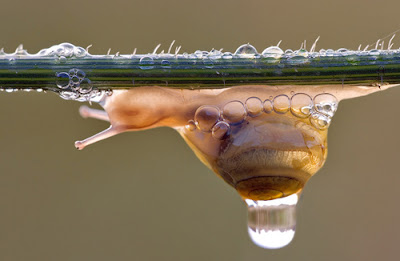A shrimplike super predator of the very old seas may have had additional than 30,000 lenses in each eye, granting the animal improved vision that would have rival or exceed that of living insects and crustaceans, a new learn says.
The finding is base on a pair of 515-million-year-old stalked eyes belong to the meter-long (three-foot-long) Anomalocaris, whose Latin name translate roughly to "weird crustacean."
The ancient eyes—each about 0.8 to 1.2 inches (2 to 3 centimeters) long—were found in shale deposits on Australia's Kangaroo Island.

Unlike umans—whose eyes each have a solitary, large lens—insects and crustaceans have eyes with multiple, usually hexagonal lenses, each of which transfer separate bits of information to the brain.
When study co-author Diego C. García-Bellido and colleagues began counting Anomalocaris's fossilized lenses beneath a microscope, they could scarcely believe their eye.We're chatting 16,000 lenses on half an eye," said García-Bellido, a paleontologist at the Spanish Research Council in Madrid."Wow—that was the most mind-blowing feature of it all."
The other side of the pair of Anomalocaris eyes is entrenched in rock and can't be studied, García-Bellido said, but it's possible both sides had equal amounts of lenses.
"Great White Shark" of Its Time?
The main animal of the Cambrian period (542 to 501 million years ago), Anomalocaris had a round, plated mouth with teeth-like serrations and spiny arms for grasping prey such as trilobites, a type of extinct arthropod.
At the Kangaroo Island site, scientists also found Anomalocaris coprolites—or fossilized poop—in the shale deposits. (Read more about fossil feces.)It's quite incredible—you find bits of pieces of trilobites in it," said García-Bellido, whose team has received funding for future work from the National Geographic Society's Committee for Research and Exploration. (The Society owns National Geographic News.)
The new study offers more proof that the creature was the super predator of its era—"probably the great white shark of the Cambrian ocean," García-Bellido said.Anomalocaris and its relations were so successful, in fact, that they lasted for another 40 million years until probable being outcompeted by fish.
The finding is base on a pair of 515-million-year-old stalked eyes belong to the meter-long (three-foot-long) Anomalocaris, whose Latin name translate roughly to "weird crustacean."
The ancient eyes—each about 0.8 to 1.2 inches (2 to 3 centimeters) long—were found in shale deposits on Australia's Kangaroo Island.

When study co-author Diego C. García-Bellido and colleagues began counting Anomalocaris's fossilized lenses beneath a microscope, they could scarcely believe their eye.We're chatting 16,000 lenses on half an eye," said García-Bellido, a paleontologist at the Spanish Research Council in Madrid."Wow—that was the most mind-blowing feature of it all."
The other side of the pair of Anomalocaris eyes is entrenched in rock and can't be studied, García-Bellido said, but it's possible both sides had equal amounts of lenses.
"Great White Shark" of Its Time?
The main animal of the Cambrian period (542 to 501 million years ago), Anomalocaris had a round, plated mouth with teeth-like serrations and spiny arms for grasping prey such as trilobites, a type of extinct arthropod.
At the Kangaroo Island site, scientists also found Anomalocaris coprolites—or fossilized poop—in the shale deposits. (Read more about fossil feces.)It's quite incredible—you find bits of pieces of trilobites in it," said García-Bellido, whose team has received funding for future work from the National Geographic Society's Committee for Research and Exploration. (The Society owns National Geographic News.)
The new study offers more proof that the creature was the super predator of its era—"probably the great white shark of the Cambrian ocean," García-Bellido said.Anomalocaris and its relations were so successful, in fact, that they lasted for another 40 million years until probable being outcompeted by fish.

















